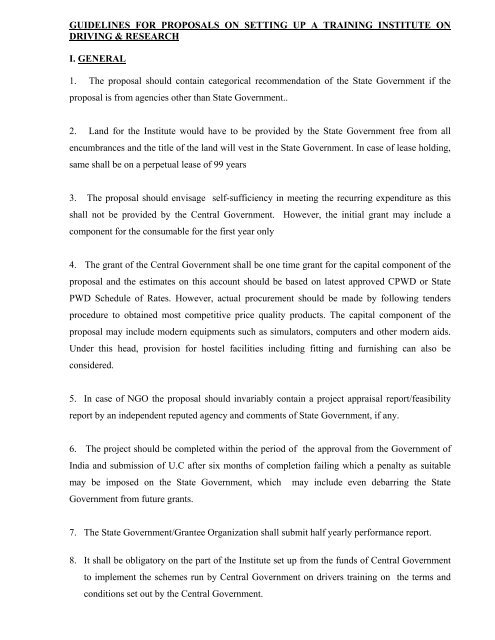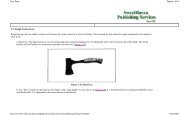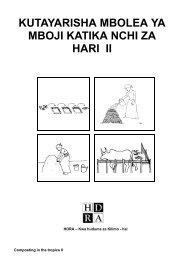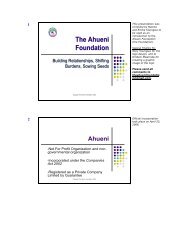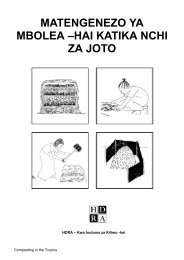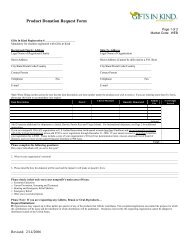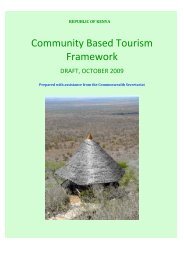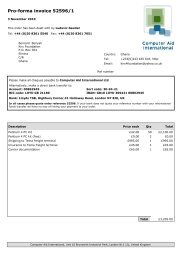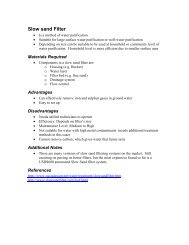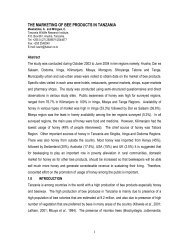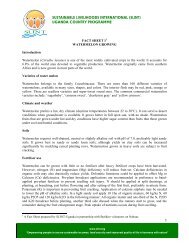guidelines for proposals on setting up a training institute - Nabuur
guidelines for proposals on setting up a training institute - Nabuur
guidelines for proposals on setting up a training institute - Nabuur
- No tags were found...
Create successful ePaper yourself
Turn your PDF publications into a flip-book with our unique Google optimized e-Paper software.
GUIDELINES FOR PROPOSALS ON SETTING UP A TRAINING INSTITUTE ON<br />
DRIVING & RESEARCH<br />
I. GENERAL<br />
1. The proposal should c<strong>on</strong>tain categorical recommendati<strong>on</strong> of the State Government if the<br />
proposal is from agencies other than State Government..<br />
2. Land <str<strong>on</strong>g>for</str<strong>on</strong>g> the Institute would have to be provided by the State Government free from all<br />
encumbrances and the title of the land will vest in the State Government. In case of lease holding,<br />
same shall be <strong>on</strong> a perpetual lease of 99 years<br />
3. The proposal should envisage self-sufficiency in meeting the recurring expenditure as this<br />
shall not be provided by the Central Government. However, the initial grant may include a<br />
comp<strong>on</strong>ent <str<strong>on</strong>g>for</str<strong>on</strong>g> the c<strong>on</strong>sumable <str<strong>on</strong>g>for</str<strong>on</strong>g> the first year <strong>on</strong>ly<br />
4. The grant of the Central Government shall be <strong>on</strong>e time grant <str<strong>on</strong>g>for</str<strong>on</strong>g> the capital comp<strong>on</strong>ent of the<br />
proposal and the estimates <strong>on</strong> this account should be based <strong>on</strong> latest approved CPWD or State<br />
PWD Schedule of Rates. However, actual procurement should be made by following tenders<br />
procedure to obtained most competitive price quality products. The capital comp<strong>on</strong>ent of the<br />
proposal may include modern equipments such as simulators, computers and other modern aids.<br />
Under this head, provisi<strong>on</strong> <str<strong>on</strong>g>for</str<strong>on</strong>g> hostel facilities including fitting and furnishing can also be<br />
c<strong>on</strong>sidered.<br />
5. In case of NGO the proposal should invariably c<strong>on</strong>tain a project appraisal report/feasibility<br />
report by an independent reputed agency and comments of State Government, if any.<br />
6. The project should be completed within the period of the approval from the Government of<br />
India and submissi<strong>on</strong> of U.C after six m<strong>on</strong>ths of completi<strong>on</strong> failing which a penalty as suitable<br />
may be imposed <strong>on</strong> the State Government, which may include even debarring the State<br />
Government from future grants.<br />
7. The State Government/Grantee Organizati<strong>on</strong> shall submit half yearly per<str<strong>on</strong>g>for</str<strong>on</strong>g>mance report.<br />
8. It shall be obligatory <strong>on</strong> the part of the Institute set <strong>up</strong> from the funds of Central Government<br />
to implement the schemes run by Central Government <strong>on</strong> drivers <strong>training</strong> <strong>on</strong> the terms and<br />
c<strong>on</strong>diti<strong>on</strong>s set out by the Central Government.
9. Initially, the <str<strong>on</strong>g>proposals</str<strong>on</strong>g> shall be c<strong>on</strong>sidered <str<strong>on</strong>g>for</str<strong>on</strong>g> the locati<strong>on</strong>s in/adjacent to the State Capital<br />
/Major towns and <strong>on</strong>ly <strong>on</strong>e proposal from a State shall be c<strong>on</strong>sidered.<br />
10. Details of a Standard Training Institute <strong>on</strong> Driving & Research is annexed.<br />
II. WHO CAN SEND THE PROPOSAL:<br />
1. State Government, and/or<br />
2. Any other agencies such as NGO/Automobile Associati<strong>on</strong>s/Vehicle<br />
Manufacturers’Associati<strong>on</strong>/Aut<strong>on</strong>omous Body/Private Vehicle Manufacturers authorized and<br />
recommended by the State Governments.<br />
3. In case of the agencies other than State Government, they should be financially sound so as to<br />
be able to run the Institute.<br />
III. CRITERIA OF THE ELIGIBILITY IN CASE OF AGENCIES OTHER THAN<br />
STATE GOVERNMENT<br />
1. Must be registered with the appropriate legal authority.<br />
2. Must be a clean record holder since incepti<strong>on</strong>.<br />
3. Must be a public c<strong>on</strong>cern or NGO, etc.<br />
4. Should have experience of 5 years in the field of Road Safety.<br />
-----<br />
DETAILS OF A STANDARD TRAINING INSTITUTE ON DRIVING & RESEARCH<br />
1.0. INTRODUCTION:<br />
A Good Driver Training Centre is aimed to develop right attitudes towards driving<br />
resp<strong>on</strong>sibilities, instills understanding of Traffic Regulati<strong>on</strong>s and create good driving habits. By<br />
merely listening or reading, the driving skills cannot be acquired. The skill has to be learned by<br />
each individual’s own practice. Haphazard learning never promises a high grade of skill. If<br />
young drivers are systematically trained, they can correct their mistakes and help reduce<br />
accidents. If the Drivers are not trained well, ultimately the general public will be endangered by<br />
their mistakes. Sound Driver Educati<strong>on</strong> and <strong>training</strong> produce good results. A properly trained<br />
generati<strong>on</strong> of new Drivers would bring down the rate of accidents c<strong>on</strong>siderably in future.
2.0. OBJECTIVES:<br />
- To c<strong>on</strong>duct inducti<strong>on</strong> <strong>training</strong> course in driving of Heavy Motor Vehicles.<br />
- To c<strong>on</strong>duct inducti<strong>on</strong> <strong>training</strong> course in driving of Light Motor Vehicles.<br />
- To c<strong>on</strong>duct <strong>training</strong> course <str<strong>on</strong>g>for</str<strong>on</strong>g> Trainers.<br />
To c<strong>on</strong>duct Refresher and Orientati<strong>on</strong> Training Courses <str<strong>on</strong>g>for</str<strong>on</strong>g> the drivers who are in service.<br />
- To c<strong>on</strong>duct <strong>training</strong> course <str<strong>on</strong>g>for</str<strong>on</strong>g> the drivers who carry dangerous/hazardous goods.<br />
- To carry out research <strong>on</strong> behavioral/attitudinal changes required to be brought out in the<br />
drivers.<br />
3.0. TRAINING SCHEMES:<br />
3.1. INDUCTION TRAINING COURSE IN HEAVY MOTOR VEHICLE DRIVING:<br />
Generally the drivers of Heavy Motor Vehicles come from cleaner stage having lack of<br />
knowledge in Traffic Rules & Regulati<strong>on</strong>s, driving skills and maintenance of vehicle and also<br />
carry all types of bad driving habits. This leads to the growth of road accident rate year by year.<br />
To overcome this, it is necessary to train heavy vehicle drivers in a systematic manner <strong>on</strong><br />
scientific lines by selecting the candidates who complete 1 year in Light Motor Vehicle Driving<br />
Licence.<br />
As per the Rule 31(3) and 31(4) of Central Motor Vehicles Rules, 1989 the <strong>training</strong> period<br />
<str<strong>on</strong>g>for</str<strong>on</strong>g> Transport Vehicles shall not be less than 30 days and Driving Hours shall not be less than 15<br />
Hours.<br />
Though the minimum Training period has been prescribed in the Central Motor Vehicle<br />
Rules, 1989, to make the drivers more skilled, the course durati<strong>on</strong> may be prescribed as 12 weeks.<br />
In the 12 weeks <strong>training</strong> period, the steering practice is proposed to be given 1 hour per<br />
day per candidate by allotting 7 candidates per vehicle per <strong>on</strong>e Driving Instructor. Totally, 72<br />
hours of steering practice and 120 hours of theory classes are proposed to be given <str<strong>on</strong>g>for</str<strong>on</strong>g> each<br />
trainee based <strong>on</strong> the syllabus prescribed <str<strong>on</strong>g>for</str<strong>on</strong>g> Heavy Motor Vehicle Driving in the Rule 31 (3) of<br />
C.M.V. Rules, 1989 (the less<strong>on</strong>s cover Parts E,F,G,H,I,J & K).<br />
In the 72 hours of steering practice each trainee may be given 1000 KMs of driving<br />
practice.<br />
shifts.<br />
One Driver Training vehicle is required to give <strong>training</strong> to 14 candidates per day in two<br />
The details of the scheme <str<strong>on</strong>g>for</str<strong>on</strong>g> imparting <strong>training</strong> in heavy motor vehicle driving is detailed<br />
in the Annexure-I.
3.2. INDUCTION TRAINING COURSE IN LIGHT MOTOR VEHICLE DRIVING<br />
The new Motor Vehicles Act, 1988 and Central Motor Vehicles Rules, 1989 are<br />
applicable to all classes of road users. Most important are the new pre-cauti<strong>on</strong>s and procedures<br />
laid down in the Driving Regulati<strong>on</strong>s in Secti<strong>on</strong> 118 of Motor Vehicles Act, 1988 which must be<br />
followed by all road users especially new road signs. Hence, the LMV drivers also be trained like<br />
heavy vehicle drivers in a systematic manner so as to improve the road safety.<br />
As per the Rule 31 (2) and 31 (4) of Central Motor Vehicles Rules, 1989, the <strong>training</strong><br />
period <str<strong>on</strong>g>for</str<strong>on</strong>g> n<strong>on</strong>-transport vehicles shall not be less than 21 days and driving hours shall not be less<br />
than 10 hours.<br />
Moreover, as per the rule 15 of C.M.V.Rules, 1989, “No pers<strong>on</strong> shall appear <str<strong>on</strong>g>for</str<strong>on</strong>g> the test of<br />
competence to drive unless he has held a learner’s licence <str<strong>on</strong>g>for</str<strong>on</strong>g> a period of at least 30 days”.<br />
In view of the above, the <strong>training</strong> course period <str<strong>on</strong>g>for</str<strong>on</strong>g> a Light Motor Vehicle <strong>training</strong> period<br />
has been prescribed as <strong>on</strong>e m<strong>on</strong>th durati<strong>on</strong>.<br />
In <strong>on</strong>e m<strong>on</strong>th durati<strong>on</strong>, it is proposed to give 20 hours of steering practice and 40 hours of<br />
theory classes <str<strong>on</strong>g>for</str<strong>on</strong>g> each trainee based <strong>on</strong> the syllabus prescribed <str<strong>on</strong>g>for</str<strong>on</strong>g> Light Motor Vehicle Driving<br />
in the Rule 31(2) of C.M.V. Rules, 1989 (the less<strong>on</strong>s cover Parts A,B,C,F,G & K).<br />
The details of the scheme <str<strong>on</strong>g>for</str<strong>on</strong>g> imparting <strong>training</strong> in LMV driving is detailed in the<br />
Annexure – II.<br />
3.3. TRAINING COURSE FOR TRAINERS :<br />
Apart from <strong>training</strong> of drivers there is a need <str<strong>on</strong>g>for</str<strong>on</strong>g> improving the standard of Driver<br />
Training Instructors.<br />
As per the Rule 24(3)(viii) of the C.M.V. Rules, 1989, the following minimum<br />
qualificati<strong>on</strong>s have been prescribed <str<strong>on</strong>g>for</str<strong>on</strong>g> Driving Instructor who is engaged <str<strong>on</strong>g>for</str<strong>on</strong>g> Driving Instructor<br />
purpose in the driving school.<br />
- a pass in the X Std.<br />
- five years driving experience<br />
- a certificate in motor mechanic course<br />
- thorough knowledge in road traffic rules and regulati<strong>on</strong>s
For a trainer to be achieved proficiency in <strong>training</strong>, he should be moulded in a proper<br />
manner so as to enable him to handle theory classes and practical sessi<strong>on</strong>s systematically. The<br />
Driving Instructor is mainly entrusted with the following resp<strong>on</strong>sibilities:<br />
- Imparting <strong>training</strong> to the trainees in the vehicle<br />
- Handling theory classes in different subjects<br />
- To oversee and s<strong>up</strong>ervise the driving per<str<strong>on</strong>g>for</str<strong>on</strong>g>mance of trainees with reference to fuel<br />
c<strong>on</strong>servati<strong>on</strong> as well as safe driving.<br />
- To evaluate the per<str<strong>on</strong>g>for</str<strong>on</strong>g>mance of the trainees.<br />
This being a primary task, a specialized <strong>training</strong> programme <str<strong>on</strong>g>for</str<strong>on</strong>g> trainers (Driving<br />
Instructors) may be c<strong>on</strong>ducted in the Training Institute. The details of the scheme <str<strong>on</strong>g>for</str<strong>on</strong>g> imparting<br />
<strong>training</strong> course <str<strong>on</strong>g>for</str<strong>on</strong>g> trainers is detailed in the Annexure-III.<br />
3.4. REFRESHER & ORIENTATION CAPSULE COURSE FOR DRIVERS WHO ARE IN<br />
SERVICE:<br />
Refresher/Orientati<strong>on</strong> Training courses <str<strong>on</strong>g>for</str<strong>on</strong>g> short durati<strong>on</strong> of 3 days or 5 days may also be<br />
c<strong>on</strong>ducted periodically in the Training Institute <str<strong>on</strong>g>for</str<strong>on</strong>g> the drivers who are in service not <strong>on</strong>ly in State<br />
Road Transport Undertakings but also in Private Sector as well as Public Sector Undertakings<br />
including Tank/Truck Drivers to inculcate a sense of resp<strong>on</strong>sibility <strong>on</strong> road safety. The courses<br />
may be c<strong>on</strong>ducted <strong>on</strong> the following topics by inviting Experts in the appropriate field.<br />
- Behavioural Practices<br />
- Defensive Driving Techniques<br />
- Traffic Rules and Regulati<strong>on</strong>s<br />
- Accident Investigati<strong>on</strong><br />
- Training Course <strong>on</strong> Safety Clinic <str<strong>on</strong>g>for</str<strong>on</strong>g> Accident Pr<strong>on</strong>e Drivers<br />
o Training Course <strong>on</strong> Fuel C<strong>on</strong>servati<strong>on</strong><br />
o Training Course <strong>on</strong> Public Relati<strong>on</strong>s<br />
o Training Course <strong>on</strong> Safe Transportati<strong>on</strong> of Dangerous and Hazardous Goods<br />
o 3 days course <str<strong>on</strong>g>for</str<strong>on</strong>g> Tanker/Truck Vehicle Endorsement in driving licence.<br />
o 1 day Refresher Course <str<strong>on</strong>g>for</str<strong>on</strong>g> Renewal of Tanker/Truck Vehicle Driving<br />
Licence<br />
4.0. INFRASTRUCTURE REQUIREMENTS:<br />
A minimum of 15 acres of land would be required to set <strong>up</strong> a Driving Training Institute<br />
with various infrastructure facilities such as class rooms with teaching aids like OHP, Slide<br />
Projector, T.V. and V.C.R./VCD and Multimedia Projector <str<strong>on</strong>g>for</str<strong>on</strong>g> handling theory classes <strong>on</strong> Traffic<br />
Rules and Regulati<strong>on</strong>s, Driving Procedures, Vehicle Mechanism, Public Relati<strong>on</strong>s and First Aid.
To display cut secti<strong>on</strong> models of various working systems of an automobile, including<br />
failed comp<strong>on</strong>ents as well as static models <strong>on</strong> driving procedures, a separate driving lab is also<br />
required.<br />
Testing equipments to test physical abilities of drivers including eye visi<strong>on</strong>, Driving<br />
Simulator, and a comprehensive driving range with various types of manoeuvres to impart offroad<br />
driving practice in basic driving procedures and driving practice in skill development are<br />
also required. A Layout of Driving Range and various facilities provided in the Driving Range<br />
<str<strong>on</strong>g>for</str<strong>on</strong>g> skill development practice may be seen in the Annexure – V.<br />
The other infrastructure such as workshop shed <str<strong>on</strong>g>for</str<strong>on</strong>g> maintenance and repairs of <strong>training</strong><br />
vehicles, canteen and Hostel facilities are also to be provided in the Institute itself. The details of<br />
the infrastructure requirement is given in the Annexure-IV.<br />
5.0 FINANCIAL IMPLICATIONS:<br />
5.1 CAPITAL INVESTMENT:<br />
The Central Government will provide 70% of the capital investment and 30% will be<br />
borne by the State Government/Grantee Organisati<strong>on</strong>.<br />
5.2 RECURRING EXPENDITURE:<br />
The total recurring expenditure shall be borne by the State Government/Grantee<br />
Organisati<strong>on</strong>.<br />
6.0 CONCLUSION:<br />
i) The capacity of the Institute may be targeted to train 280 heavy vehicle drivers, 360<br />
light vehicle drivers and 120 driving instructors per annum at the minimum.<br />
ii) The Institute shall also c<strong>on</strong>duct short term Refresher courses <str<strong>on</strong>g>for</str<strong>on</strong>g> Public and Private<br />
Sector Undertakings’ drivers who are in service and a special <strong>training</strong> course <str<strong>on</strong>g>for</str<strong>on</strong>g> tank/truck<br />
drivers who carry hazardous/dangerous goods <str<strong>on</strong>g>for</str<strong>on</strong>g> about 400 drivers per annum to reduce accident<br />
rate and improve road safety.<br />
The annual turn out may be increased in a phased manner depending <strong>up</strong><strong>on</strong> the increase of<br />
infrastructural facilities.
iii) To create more awareness in road safety, the <strong>training</strong> <strong>institute</strong> may c<strong>on</strong>duct certain<br />
theory classes <strong>on</strong> road traffic rules and regulati<strong>on</strong>s and defensive driving techniques, at the rate of<br />
1 hour per day per candidate (similar to First Aid classes c<strong>on</strong>ducted by St. John’s Ambulance<br />
Associati<strong>on</strong>) <str<strong>on</strong>g>for</str<strong>on</strong>g> the candidates who appear <str<strong>on</strong>g>for</str<strong>on</strong>g> fresh driving licence and at the time of renewal of<br />
driving licence with the associati<strong>on</strong> of Transport Authorities.<br />
iv) The <strong>training</strong> <strong>institute</strong> may also be utilized by the Transport Authorities to test the<br />
driving abilities of the candidates from public who appear <str<strong>on</strong>g>for</str<strong>on</strong>g> M.V.I’s Test <str<strong>on</strong>g>for</str<strong>on</strong>g> driving licence.
ANNEXURE-I<br />
SCHEME FOR INDUCTION TRAINING COURSE<br />
IN HEAVY MOTOR VEHICLE DRIVING<br />
1) MINIMUM STANDARDS REQUIRED FOR TRAINEES:<br />
The minimum requirements <str<strong>on</strong>g>for</str<strong>on</strong>g> the trainees to undergo Heavy Vehicle Driver Training<br />
are given as below :<br />
Educati<strong>on</strong> : Fluent in reading and writing in<br />
Regi<strong>on</strong>al Language.<br />
Driving Licence : 1 year completed in Light Motor<br />
Vehicle Driving.<br />
Physical C<strong>on</strong>diti<strong>on</strong> : Good visi<strong>on</strong> and free from other<br />
Physical disabilities.<br />
2) COURSE DURATION : 12 Weeks<br />
3) SYLLABUS:<br />
The syllabus as prescribed in Rule 31(3) of Central Motor Vehicles rules, 1989 <str<strong>on</strong>g>for</str<strong>on</strong>g> Heavy<br />
Motor Vehicles (the less<strong>on</strong>s cover parts E, F, G, H, I, J & K) may be followed.<br />
4) COURSE CONTENTS:<br />
Theory<br />
Driving Practice<br />
Topic No. of Weeks Topic No. of Weeks<br />
Driving Theory - 2 Basic Driving Practice - 2<br />
(in Driving Range)<br />
Traffic Educati<strong>on</strong> - 2 Skill Driving Practice - 2<br />
(in Driving Range)<br />
Vehicle Mechanism - 2 Driving Practice in Rural - 4<br />
Theory<br />
and Highway Roads<br />
Vehicle Maintenance - 2 Driving Practice in City - 4<br />
& Repairs<br />
Roads (in Dense and Lane<br />
Traffic)<br />
Public Relati<strong>on</strong>s - 2<br />
First Aid - 1<br />
Human Relati<strong>on</strong> - 1<br />
----- -------<br />
Total : 12 12<br />
----- -------<br />
5) EVALUATION:<br />
At the end of the Training Course, the trainees are evaluated totally 700 Marks in Theory<br />
as well as in Driving Practice. The minimum requirement of marks <str<strong>on</strong>g>for</str<strong>on</strong>g> pass in each subject is as<br />
follows:<br />
Maximum<br />
Minimum Marks<br />
Marks<br />
required <str<strong>on</strong>g>for</str<strong>on</strong>g> pass<br />
Driving Practice 300 180
Theory:<br />
Traffic Educati<strong>on</strong> 100 40<br />
Driving Theory 100 40<br />
Vehicle Mechanism 100 40<br />
Theory & Practical<br />
Public Relati<strong>on</strong>s 100 40<br />
-------- -------<br />
Total : 700 340<br />
-------- -------<br />
6) ELIGIBILITY TO WRITE EXAMINATION:<br />
A minimum of 85% attendance is required.<br />
7) EXTENSION OF TRAINING:<br />
For shortage of attendance or failure in Driving Practice, the <strong>training</strong> period will be<br />
extended in terms of weeks i.e. 1 or 2 weeks (or) depending <strong>up</strong><strong>on</strong> the candidates requirement by<br />
collecting additi<strong>on</strong>al fee.<br />
8) FAILURE IN EXAMINATION:<br />
If anybody fails in any theory paper or driving practice, the candidate has to re-appear <str<strong>on</strong>g>for</str<strong>on</strong>g><br />
the Examinati<strong>on</strong>.<br />
9) TEST:<br />
The Trainees those who passed the driving Per<str<strong>on</strong>g>for</str<strong>on</strong>g>mance Test called Internal Trade<br />
Test c<strong>on</strong>ducted by the Institute will <strong>on</strong>ly be sent to Motor Vehicle Inspector’s Test <str<strong>on</strong>g>for</str<strong>on</strong>g><br />
Heavy Vehicle Driving Licence Endorsement.10) CERTIFICATE:<br />
After passing in all Theory papers and Motor Vehicle Inspector’s Test, the Proficiency Test<br />
Certificate will be issued to the candidates.
ANNEXURE-II<br />
SCHEME FOR INDUCTION TRAINING COURSE IN<br />
LIGHT MOTOR VEHICLE DRIVING<br />
1) MINIMUM STANDARDS REQUIRED FOR TRAINEES :<br />
The minimum requirements <str<strong>on</strong>g>for</str<strong>on</strong>g> the trainees to undergo Light Motor Vehicle Driving<br />
Training are given as below :<br />
Educati<strong>on</strong> : Fluent in reading and writing in<br />
Regi<strong>on</strong>al Language<br />
Physical C<strong>on</strong>diti<strong>on</strong> : Good visi<strong>on</strong> and free from other<br />
Physical disabilities.<br />
2) COURSE DURATION : 4 Weeks<br />
3) SYLLABUS :<br />
The syllabus as prescribed in Rule 31 (2) of Central Motor Vehicles<br />
Rules, 1989 <str<strong>on</strong>g>for</str<strong>on</strong>g> Light Motor Vehicles (the less<strong>on</strong>s cover parts A, B, C, F, G &<br />
K) may be followed.<br />
4) COURSE CONTENTS :<br />
Theory<br />
Driving Practice<br />
Topic No. of Weeks Topic No. of Weeks<br />
Driving Theory - 1 Basic Driving Practice - 1<br />
(in Driving Range)<br />
Traffic Educati<strong>on</strong> - 1 Skill Driving Practice - 1<br />
(in Driving Range)<br />
Basic Vehicle - 1 Driving Practice in Rural - 1<br />
Mechanism Theory<br />
and Highway Roads<br />
& Practical<br />
Driving Practice in City - 1<br />
Roads (in Dense and Lane<br />
Traffic)<br />
Public Relati<strong>on</strong>s & - 1<br />
First Aid ----- ------<br />
Total : 4 4<br />
----- -----
5) EVALUATION:<br />
At the end of the Training Course, the trainees are evaluated in Theory as well as in<br />
Driving Practice.<br />
6) ELIGIBILITY TO WRITE EXAMINATIONS:<br />
A minimum of 85% attendance is required.<br />
7) EXTENSION OF TRAINING:<br />
For shortage of attendance or failure in Driving Practice, the <strong>training</strong> period may be<br />
extended in terms of weeks i.e. 1 or 2 weeks.<br />
8) FAILURE IN EXAMINATION:<br />
9) TEST:<br />
If anybody fails in any theory paper or driving practice, the candidate has to re-appear.<br />
The Trainees who passed the Driving Per<str<strong>on</strong>g>for</str<strong>on</strong>g>mance Test called Internal Trade Test<br />
c<strong>on</strong>ducted by the Institute will <strong>on</strong>ly be sent to Motor Vehicle Inspector’s Test <str<strong>on</strong>g>for</str<strong>on</strong>g> Light Motor<br />
Vehicle Driving Licence Endorsement.<br />
10) CERTIFICATE:<br />
After passing in all Theory papers and Motor Vehicle Inspector’s Test, the ProficiencyTest<br />
Certificate may be issued to the candidates.<br />
----
ANNEXURE-III<br />
SCHEME FOR TRAINING COURSE FOR TRAINERS<br />
1) MINIMUM STANDARDS REQUIRED FOR TRAINEES:<br />
The minimum requirements <str<strong>on</strong>g>for</str<strong>on</strong>g> the trainees to undergo the “Training Course <str<strong>on</strong>g>for</str<strong>on</strong>g> Trainers”<br />
course is given as below:<br />
Educati<strong>on</strong> : a pass in X Std.<br />
Driving Experience : 5 years<br />
Certificate : a certificate in motor mechanic course<br />
Knowledge : Thorough knowledge in road traffic rules and<br />
regulati<strong>on</strong>s<br />
2) COURSE DURATION : 4 Weeks<br />
3) COURSE CONTENTS:<br />
Theory<br />
Driving Practice<br />
(A.M. Sessi<strong>on</strong>)<br />
(P.M. Sessi<strong>on</strong>)<br />
Topic No. of Weeks Topic No. of Weeks<br />
Driving Theory - 1<br />
Traffic Educati<strong>on</strong> - 1 Skill Driving Practice - 1<br />
(in Driving Range)<br />
Vehicle Mechanism - 1 Driving Practice in Rural - 1<br />
Theory & Practicals<br />
and Highway Roads<br />
Instructi<strong>on</strong>al Techniques, 1 Driving Practice in City - 1<br />
Human Relati<strong>on</strong>s,<br />
Roads (in Dense and Lane<br />
Public Relati<strong>on</strong>s,<br />
Traffic)<br />
Aids Awareness Visi<strong>on</strong> Test, Reacti<strong>on</strong> Test, - 1<br />
First Aid<br />
Theory Test & Driving Skill<br />
Film Show<br />
Test<br />
------- ------<br />
Total : 4 4<br />
------- ------<br />
4) EVALUATION:<br />
in driving skills.<br />
At the end of the Training Course, the trainees may be evaluated in theory porti<strong>on</strong>s and<br />
5) CERTIFICATE:<br />
A certificate also may be awarded who successfully completes the Training Course.
ANNEXURE – IV<br />
DETAILS OF INFRASTRUCTURE REQUIREMENT<br />
1. Land:<br />
To establish a full fledged driving center with various infrastructure facilities such as class<br />
rooms, office room, workshop, driving laboratory, hostels, canteen and driving range, a minimum<br />
of 15 acres of land is required.<br />
2. Buildings:<br />
i) Class Rooms:<br />
For handling theory classes, 3 class rooms of size each 6 m x 8 m are required in which 1 class<br />
room will be utilized <str<strong>on</strong>g>for</str<strong>on</strong>g> Heavy vehicle driver trainees, sec<strong>on</strong>d <strong>on</strong>e will be utilized <str<strong>on</strong>g>for</str<strong>on</strong>g> light<br />
vehicle driver trainees and another <strong>on</strong>e will be utilized <str<strong>on</strong>g>for</str<strong>on</strong>g> c<strong>on</strong>ducting refresher and special<br />
<strong>training</strong> courses <str<strong>on</strong>g>for</str<strong>on</strong>g> the drivers who are in service including the drivers who carry<br />
hazardous/dangerous goods.<br />
ii) Office and Staff Rooms:<br />
Three more rooms of size each 6 m x 8 m are required <str<strong>on</strong>g>for</str<strong>on</strong>g> the use of office and staff.<br />
iii) Driving Laboratory:<br />
One hall of size 36 m x 8 m is required to display various systems and cut secti<strong>on</strong> models of<br />
vehicle and to display models about various driving procedures.<br />
iv) Workshop:<br />
One shed of size 20 m x 12 m with A.C. sheet roof is also required to carryout day to day repair<br />
works and maintenance of the <strong>training</strong> vehicles.<br />
v) Canteen:<br />
For the benefit of trainees, canteen facilities are also proposed to be provided in a separate<br />
building of size 36 m x 8 m including recreati<strong>on</strong> with necessary furniture and fittings.<br />
(vi) Hostels:<br />
For the benefit of the trainees, hostel facilities also may be provided within the Training Institute<br />
campus including recreati<strong>on</strong> facilities. To accommodate about 50 candidates at a time, a<br />
minimum <strong>on</strong>e Hostel Block of size 46 m x 6 m with 8 rooms of size each 5 m x 4 m may be<br />
c<strong>on</strong>structed.
3. Furniture and Fittings:<br />
i) For trainees: For each trainee a chair-cum-writing pad may be provided in the class rooms.<br />
To handle classes at a time <str<strong>on</strong>g>for</str<strong>on</strong>g> 35 heavy vehicle driver trainees, 15 light vehicle driver trainees<br />
and about 50 drivers of refresher & special <strong>training</strong> courses, 100 nos. of chair-cum-writing desk<br />
al<strong>on</strong>g with fittings may be provided.<br />
ii) For staff: For office and staff also necessary furniture and fittings may be provided.<br />
4. Vehicles:<br />
To start with, it is proposed to train about 280 heavy vehicle drivers, 360 light vehicle drivers and<br />
to c<strong>on</strong>duct refresher courses <str<strong>on</strong>g>for</str<strong>on</strong>g> about 400 serving drivers per annum, a minimum of 7 heavy<br />
motor vehicles, 3 light motor vehicles are required.<br />
5. Teaching and Training Equipments:<br />
i) Working Models of various systems of an Automobile:<br />
- Cooling System<br />
- Transmissi<strong>on</strong> System<br />
- Fuel system<br />
- Electrical system<br />
ii) Cut Secti<strong>on</strong> Models:<br />
Working Models<br />
N<strong>on</strong>-Working Models<br />
- Petrol Engine ( 4 Cylinder) - Fr<strong>on</strong>t axle with Pull & Push Rod<br />
- Diesel Engine (4 Cylinder) and Tie rod Assembly<br />
- Diesel Engine (6 Cylinder) - Gear Box Assembly<br />
- Rear Axle Assembly - Steering Box Assembly<br />
- Brake Chamber<br />
- E-1 Brake Valve<br />
- Air Filter<br />
- Unloader Valve<br />
iii) Failed Comp<strong>on</strong>ents:<br />
- Clutch cover Assembly - Axle Shaft<br />
- Clutch Disc - Crown wheel with pini<strong>on</strong><br />
- Gear Box Gears: - Starter Motor<br />
Top Gear Shaft<br />
- Alternator<br />
Main Shaft<br />
Counter Gear<br />
iv) Static Models in Driving Procedures:<br />
With the help of the Vehicle Toys the following driving<br />
procedures may also be displayed :<br />
- MSM & PSL Safety Routines<br />
- IPDE Principle<br />
- Stopping Distance<br />
- Following Distance<br />
- Curve Handling
v) Traffic Sign Boards<br />
vi) Over head Projector<br />
vii) Slide Projector<br />
viii) TV & VCR/VCD<br />
ix) Multimedia Projector<br />
xi) Transperancy sheets<br />
xii) 16 mm Slides<br />
xiii) VHS<br />
xiv) VCDs<br />
x) Magnetic Board<br />
6. Workshop Equipments:<br />
To carry out day-to-day repairs and maintenance of vehicles, complete set of tools and other<br />
accessories such as air compressor, puncture kit with tyre lever, wheel brace, jack and tyre<br />
pressure guage, trolley jack, grease gun, spanners ( a set each of fix spanners, box spanners,<br />
pliers, screw drivers, screw spanners and hammer), battery charger, a fully equipped first aid box<br />
are required <str<strong>on</strong>g>for</str<strong>on</strong>g> workshop <str<strong>on</strong>g>for</str<strong>on</strong>g> use in emergency.<br />
7. Testing equipments:<br />
To check the physical abilities of the drivers including visi<strong>on</strong> test, the following reacti<strong>on</strong><br />
testing equipments are also proposed to provide in the Driver Training Institute.<br />
- Keyst<strong>on</strong>e Eye visi<strong>on</strong> Screener - Imported from U.K.<br />
- Visi<strong>on</strong> Tester <str<strong>on</strong>g>for</str<strong>on</strong>g> Low - Imported from Japan<br />
Luminance adaptati<strong>on</strong><br />
- Acti<strong>on</strong> Judgment Tester - “<br />
- Digital Type speed anticipati<strong>on</strong> - “<br />
Reacti<strong>on</strong> Tester<br />
- Electric depth percepti<strong>on</strong> tester - “<br />
- Digital type discriminative - “<br />
Reacti<strong>on</strong> Tester<br />
To check colour blindness, a book called “Test <str<strong>on</strong>g>for</str<strong>on</strong>g> Colour Blindness” produced by Dr.<br />
Shinobu Ishihara, Japan may also be used.<br />
8. Office Equipments:<br />
Typewriter, Xerox Machine and Computers with accessories.<br />
9. Library:<br />
One Library may also be established <str<strong>on</strong>g>for</str<strong>on</strong>g> the benefit of the trainees covering books <strong>on</strong> traffic<br />
rules and regulati<strong>on</strong>s, driving procedures, vehicle maintenance and repairs.<br />
10. Driver Training Simulator:
To impart Driver Training in a scientific manner and to evaluate trainees’ driving per<str<strong>on</strong>g>for</str<strong>on</strong>g>mance<br />
at the end of the <strong>training</strong> course without bias and to test the skills of drivers based <strong>on</strong> <strong>on</strong>e’s<br />
reacti<strong>on</strong>s under various traffic and roadway c<strong>on</strong>diti<strong>on</strong>s, driver <strong>training</strong> simulators may also be<br />
provided in the Training Institute.<br />
11. Driving Range:<br />
A Driving Range is also proposed to <str<strong>on</strong>g>for</str<strong>on</strong>g>mulate by incorporating different types of<br />
manoeuvres to impart off-road driving practice so as to learn basic driving procedures and<br />
practice driving skills in various situati<strong>on</strong>s. The details of roads proposed to be provided with<br />
various manoeuvres in the driving range and its purpose is as explained below: (vide Annexure –<br />
V).
Annexure - V<br />
Road<br />
Purpose<br />
i) Two Lane Straight : Used <str<strong>on</strong>g>for</str<strong>on</strong>g> freshers to impart Basic Driving Practice i.e.<br />
Road starting – moving – stopping – gear changing – steering c<strong>on</strong>trol –<br />
passing – overtaking – curve handling – driving in crawling speed –<br />
low speed – average speed – high speed – following distance –<br />
stopping distance – stopping the vehicle in case of brake failure,<br />
etc. can be practiced.<br />
ii) Parking : Practice in 3 types of parking manoeuvres i.e. parking in parallel,<br />
angular and perpendicular to road. Simulating parking operati<strong>on</strong>s in<br />
bus stati<strong>on</strong>s and truck parks.<br />
iii) Hump Road : Parking, stopping and starting operati<strong>on</strong>s <strong>on</strong> sloped road i.e. to<br />
practice clutch balance point and bitting point and also cautious<br />
driving due to reduced sight distance.<br />
iv) Dip Road : To educate the trainees to know the level of water stream in the<br />
causeway and the driving procedure to be adopted while drivingin<br />
such water streams.<br />
v) 3 Point Turn & : This is to train the drivers <strong>on</strong> difficult turning <strong>on</strong> restricted roads 5<br />
Point Turn to take U-Turn.<br />
vi) S-Shaped Bend : To familiarize the trainees with difficult manoeuvres and without<br />
much of decelarati<strong>on</strong>/accelerati<strong>on</strong>.<br />
vii) 8-Shaped Bend : To train the drivers <strong>on</strong> left and right steering, sharp turning and<br />
negotiating round abouts.<br />
viii) Cul-de-sac with : To educate drivers <strong>on</strong> proper methods of reversing and<br />
side road<br />
turning.<br />
Arrangement<br />
ix) 4 Lane and : Lane changing, Lane selecti<strong>on</strong> and Lane discipline,<br />
6 Lane Road stopping be<str<strong>on</strong>g>for</str<strong>on</strong>g>e stop line, juncti<strong>on</strong> approach, etc. can be practiced.<br />
x) Speed Tract : C<strong>on</strong>trolling of vehicle in emergency situati<strong>on</strong>s such as Two<br />
Lane Road brake failure, tyre burst, etc.<br />
12. Driving Range Aids:
The Driving Range Aids such as erecti<strong>on</strong> of road traffic signs and automatic light signals,<br />
road markings, traffic barriers, traffic bollards, lighting and other road furniture and appurtenance<br />
may also be provided in the driving range.


